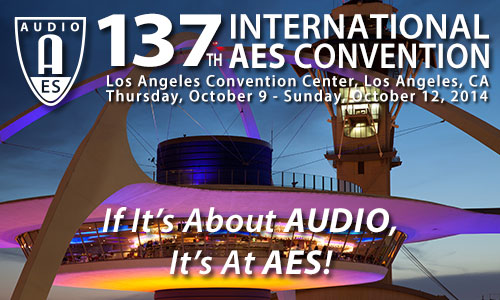
AES Los Angeles 2014
Engineering Brief EB2
EB2 - eBriefs—Poster Session 2
Friday, October 10, 10:30 am — 12:00 pm (S-Foyer 1)
EB2-1 Android Framework Implementation of 3D Audio with Range Control—Phyo Ko Ko, Nanyang Technological University - Singapore; Kaushik Sunder, Nanyang Technological University - Singapore, Singapore; Woon-Seng Gan, Nanyang Technological University - Singapore, Singapore
Due to the rapid improvement in processing power of mobile devices, real-time 3D audio rendering is becoming a reality on these devices. Using 3D audio rendering, many interesting applications, such as teleconferencing and immersive gaming can be developed. In this paper, an Android framework is developed for rendering 3D audio in real-time with additional range control. Range-dependent head related transfer functions (HRTFs) are used in order to render the spatial audio. Distance dependent HRTFs are extremely tedious to be measured since these measurements have to be carried out for several distances in the near-field. In this work, the range-dependent HRTFs used by the Android framework are experimentally measured in the horizontal plane and made available online for the researchers to use. This 3D audio framework will serve as a useful platform to deliver new audio processing applications, such as teleconferencing over headphones, personalized hearing in gaming and virtual reality etc.
Engineering Brief 161 (Download now)
EB2-2 Flexible Audio Rendering for Arbitrary Input and Output Layouts—Hyunjoo Chung, Samsung Electronics Co. Ltd. - Suwon, Korea; Sang Bae Chon, Samsung Electronics Co. Ltd. - Suwon, Korea; Sunmin Kim, Samsung Electronics Co. Ltd. - Suwon, Korea
This engineering brief introduces a rendering method compatible with various input audio formats and output reproduction layouts. By using audio scene analysis, N-channel audio input signals are converted to channel-independent spatial parameters then sound fields are rendered based on the M-channel output loudspeaker layout with maintaining spatial information of original audio formats. Therefore, proposed method enabled N-to-M flexible audio rendering with immersive sound perception.
Engineering Brief 163 (Download now)
EB2-3 A Touchpad-Based Method for Inducing Attentional Tunneling—Durand R. Begault, NASA Ames Research Center - Moffett Field, CA, USA; Bonny R. Christopher, San Jose State University Research Foundation, NASA Ames Research Center - Moffett Field, CA, USA; Charlotte Zeamer, NASA Ames Research Center - Moffett Field, CA, USA; Mark R. Anderson, NASA Ames Research Center - Moffett Field, CA, USA; Kirstianna Burns, City College of San Francisco - San Francisco, CA, USA
Attentional tunneling is a recognized problem for aviation safety in the flight deck. A prototype system (touchpad and associated application and experimental software) was developed and evaluated for its success in inducing attentional tunneling in a reliable and predictable manner in training and experimental contexts. An experiment with ten participants using the system examined baseline performance for visual memory of a color or number sequence, simultaneous with performing a competing auditory detection task. Spatial auditory separation of the auditory stimuli was also evaluated. Data are provided for various aspects of touchpad entry (accuracy, speed) as well as hit and false alarm rates for the auditory task. The results will help determine means of inducing attentional tunneling in more complex flight simulator experiments and for developing an inexpensive prototype for pilots to measure cognitive fixation and develop mitigation strategies.
Engineering Brief 164 (Download now)
EB2-4 The Open Multitrack Testbed—Brecht De Man, Queen Mary University of London - London, UK; Mariano Mora-Mcginity, Queen Mary University of London - London, UK; György Fazekas, Queen Mary University of London - London, UK; Joshua D. Reiss, Queen Mary University of London - London, UK
We introduce the Open Multitrack Testbed, an online repository of multitrack audio, mixes or processed versions thereof, and corresponding mix settings or process parameters such as DAW files. Multitrack audio is a much sought after resource for audio researchers, students, and content producers, and while some online resources exist, few are large and reusable and none allow querying audio fulfilling specific criteria. The test bed we present contains a semantic database of metadata corresponding with the songs and individual tracks, enabling users to retrieve all pop songs featuring an accordion, or all tracks recorded in reverberant spaces. The open character is made possible by requiring the contributions, mainly from educational institutions and individuals, to have a Creative Commons license.
Engineering Brief 165 (Download now)
EB2-5 Maintenance Considerations in Higher Education Facilities—Daniel Gonko, Western Carolina University - Cullowhee, NC, USA
Running and maintaining a recording studio in a higher education environment poses various benefits and challenges that are not often encountered in commercial facilities. This presentation will examine the pros and cons of working in such a facility, including availability, funding considerations, and training needs. The Center for Applied Technology and Commercial and Electronic Music degree program at Western Carolina University will be utilized as a case study.
Engineering Brief 166 (Download now)
